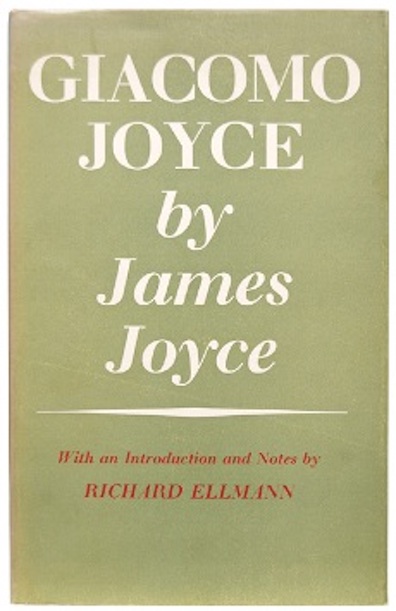Written in Trieste
in the early 1910s and not published until
after Joyce's death
, Giacomo Joyce is
a kind of notebook of artistic sketches—fifty highly
poetic prose fragments, with a few interspersed lines of verse,
carefully copied out on sixteen pages. It tracks Joyce's
romantic infatuation with one of his English-language students
in Trieste, or possibly an imaginative composite of several of
them. Richard Ellmann, who saw the work into print, writes in
his Introduction to the Faber and Faber edition (1968) that
Joyce decided to "pillage rather than publish" the collection
(xvi). Many bits of it appear, intact or rewritten, in
A
Portrait of the Artist, Exiles, and
Ulysses.
Here is one: "Twilight. Crossing the piazza. Grey eve
lowering on wide sagegreen pasturelands, shedding silently
dusk and dew. She follows her mother with ungainly grace, the
mare leading her filly foal. Grey twilight moulds softly the
slim and shapely haunches, the meek supple tendonous neck, the
fine-boned skull" (3). Joyce changed these sentences very
little in Ulysses: "A region where grey twilight
ever descends, never falls on wide sagegreen pasturefields,
shedding her dusk, scattering a perennial dew of stars. She
follows her mother with ungainly steps, a mare leading her
fillyfoal. Twilight phantoms are they, yet moulded in
prophetic grace of structure, slim shapely haunches, a
supple tendonous neck, the meek apprehensive skull." In
the original version Joyce imagistically renders a girl
following her mother across a dusky Triestine plaza as horses
in a grey-green field. In Oxen he offers only a vision
of "phantoms" in some unknown cosmic "region," leaving it to
readers to infer that they may have some connection to a human
mother and daughter.
But that metaphorical connection is still very much implied.
That Bloom is thinking about Molly and, especially, Milly
becomes clear several sentences later when an "equine portent"
rises in the heavens: "It is she, Martha, thou lost one,
Millicent, the young, the dear, the radiant." The girlish
figure becomes "a queen among the Pleiades," wrapped in a
transparent veil: "It floats, it flows about her starborn
flesh and loose it streams, emerald, sapphire, mauve
and heliotrope, sustained on currents of cold interstellar
wind, winding, coiling." Once again, Joyce has reworked
one of the visionary impressions in Giacomo: "She
speaks. A weak voice from beyond the cold stars.... She coils
towards me along the crumpled lounge. I cannot move or speak.
Coiling approach of starborn flesh" (15). This time the
revisions are more significant, but the continued presence of
"starborn flesh," "cold interstellar" wind, and "coiling"
identify the source unmistakably.
